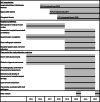Evaluation of the impact of childhood 13-valent pneumococcal conjugate vaccine introduction on adult pneumonia in Ulaanbaatar, Mongolia: study protocol for an observational study
- PMID: 34556065
- PMCID: PMC8460191
- DOI: 10.1186/s12889-021-11776-8
Evaluation of the impact of childhood 13-valent pneumococcal conjugate vaccine introduction on adult pneumonia in Ulaanbaatar, Mongolia: study protocol for an observational study
Abstract
Background: Community-acquired pneumonia is an important cause of morbidity and mortality in adults. Approximately one-third of pneumonia cases can be attributed to the pneumococcus. Pneumococcal conjugate vaccines (PCVs) protect against colonisation with vaccine-type serotypes. The resulting decrease in transmission of vaccine serotypes leads to large indirect effects. There are limited data from developing countries demonstrating the impact of childhood PCV immunisation on adult pneumonia. There are also insufficient data available on the burden and severity of all-cause pneumonia and respiratory syncytial virus (RSV) in adults from low resource countries. There is currently no recommendation for adult pneumococcal vaccination with either pneumococcal polysaccharide vaccine or PCVs in Mongolia. We describe the protocol developed to evaluate the association between childhood 13-valent PCV (PCV13) vaccination and trends in adult pneumonia.
Methods: PCV13 was introduced into the routine childhood immunisation schedule in Mongolia in a phased manner from 2016. In March 2019 we initiated active hospital-based surveillance for adult pneumonia, with the primary objective of evaluating trends in severe hospitalised clinical pneumonia incidence in adults 18 years and older in four districts of Ulaanbaatar. Secondary objectives include measuring the association between PCV13 introduction and trends in all clinically-defined pneumonia, radiologically-confirmed pneumonia, nasopharyngeal carriage of S. pneumoniae and pneumonia associated with RSV or influenza. Clinical questionnaires, nasopharyngeal swabs, urine samples and chest radiographs were collected from enrolled patients. Retrospective administrative and clinical data were collected for all respiratory disease-related admissions from January 2015 to February 2019.
Discussion: Establishing a robust adult surveillance system may be an important component of monitoring the indirect impact of PCVs within a country. Monitoring indirect impact of childhood PCV13 vaccination on adult pneumonia provides additional data on the full public health impact of the vaccine, which has implications for vaccine efficiency and cost-effectiveness. Adult surveillance in Mongolia will contribute to the limited evidence available on the burden of pneumococcal pneumonia among adults in low- and middle-income countries, particularly in the Asia-Pacific region. In addition, it is one of the few examples of implementing prospective, population-based pneumonia surveillance to evaluate the indirect impact of PCVs in a resource-limited setting.
Keywords: Adult pneumonia; Indirect PCV impact; Mongolia; Nasopharyngeal carriage; Pneumococcal conjugate vaccine; Streptococcus pneumoniae; Surveillance.
© 2021. The Author(s).
Conflict of interest statement
BDG and RB are employees of Pfizer Inc. and provided input on the study protocol and manuscript. EMD is currently an employee of Pfizer Inc. (from August 2021), but worked for MCRI at the time that the microbiological field and laboratory protocols were developed. CvM, MU, LAHD, CDN, BS, DL, DN, AJ, CS, BD, TM and EKM are investigators on this collaborative research project funded by Pfizer.
Figures
References
-
- Said MA, Johnson HL, Nonyane BA, Deloria-Knoll M, O'Brien KL, Team AAPBS. Andreo F, Beovic B, Blanco S, Boersma WG, et al. Estimating the burden of pneumococcal pneumonia among adults: a systematic review and meta-analysis of diagnostic techniques. PLoS One. 2013;8(4):e60273. doi: 10.1371/journal.pone.0060273. - DOI - PMC - PubMed
-
- Kalina WV, Souza V, Wu K, Giardina P, McKeen A, Jiang Q, Tan C, French R, Ren Y, Belanger K, McElhiney S, Unnithan M, Cheng H, Mininni T, Giordano-Schmidt D, Gessner BD, Jansen KU, Pride MW. Qualification and clinical validation of an immunodiagnostic assay for detecting 11 additional Streptococcus pneumoniae serotype-specific polysaccharides in human urine. Clin Infect Dis. 2020;71(9):e430–e438. doi: 10.1093/cid/ciaa158. - DOI - PMC - PubMed
-
- Pride MW, Huijts SM, Wu K, Souza V, Passador S, Tinder C, Song E, Elfassy A, McNeil L, Menton R, French R, Callahan J, Webber C, Gruber WC, Bonten MJM, Jansen KU. Validation of an immunodiagnostic assay for detection of 13 Streptococcus pneumoniae serotype-specific polysaccharides in human urine. Clin Vaccine Immunol. 2012;19(8):1131–1141. doi: 10.1128/CVI.00064-12. - DOI - PMC - PubMed
Publication types
MeSH terms
Substances
LinkOut - more resources
Full Text Sources
Medical


